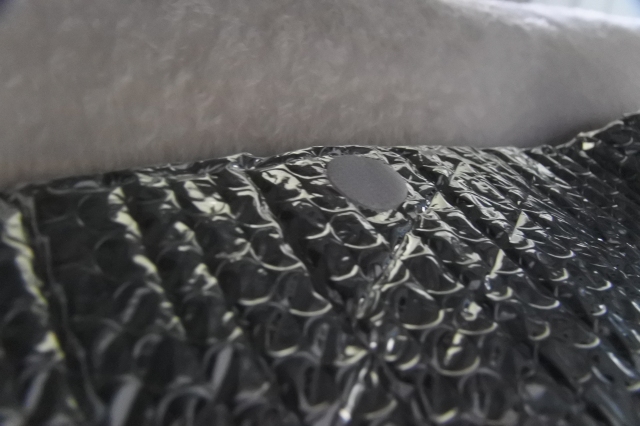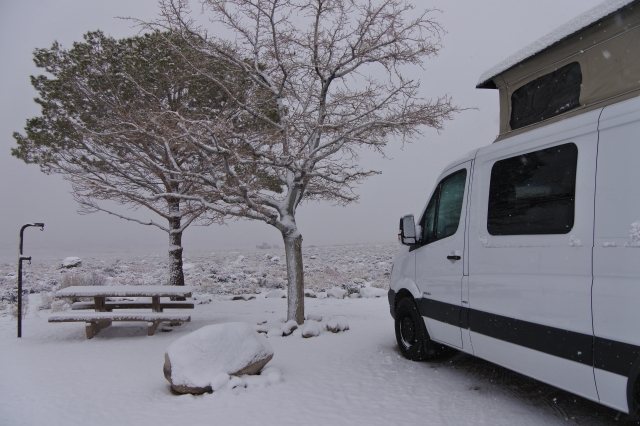One of our favorite times to travel is during the cold weather months. Especially visiting a national/state park that is usually too congested or too hot during the summer. During these months, there is less crowds, more breathing space and it seems just easier to get around. Many parks (which are not covered in snow) have campgrounds that are open year-round and many are first-come, first-serve because there is usually ample space. Of course, the downside is – the freezing cold and the pouring rain! Also, how we in California define freezing cold is surely going to be different than someone from, say, Alaska (or the east coast right now). In the past, for the most part, we’ve been able to just “get by” with cold weather camping in the campervan (no snow camping yet). We’ve been a little hesitant since we have a penthouse roof top, which has sides that are made of heavy canvas. After doing a little research on what other people were doing to stay warm in their vehicles, I decided to make a few minor changes to our campervan as well. I am certainly no expert in “winterizing campervans,” but the few changes we made, resulted in a much more comfortable winter camping trip last December.
What we’ve relied on in the past was a good, cold weather sleeping bag and the heater. The heater works great, but it makes a kind of clicking noise which carries. So, we don’t usually turn the heater on too early in the morning or too late at night to be considerate of our campground neighbors. The biggest issue for our campervan in the winter has been heat loss or the lack of heat retention. During the night it gets very cold in the van. Sleeping up in the penthouse top which is made of heavy canvas, you can feel the cold around you. It just keeps getting colder as the night goes on. So, preventing heat loss seemed like a good place to start to making the campervan more comfortable.
Insulating with Reflectix:
Using Reflectix for insulation seems like a common, tried-and-true method that people have been using for RVs. Insulating our windows with Reflectix seemed like a good first step. I ordered a roll of Reflectix (Amazon sells them in various sized rolls) and cut out pieces that were a tiny bit larger than the actual size of the windows. The piece for the side window and the two back windows, I cut larger to allow for the use of velcro dots. A few of the windows needed velcro dots to hold them in place, but for the most part the Reflectix stayed put tucked around the windows. The large piece on the sliding door stayed put (when affixed with velcro dots) and didn’t have to be removed if we needed to open or close the door. We had 5 pieces of Reflectix of various sizes for all our windows (except the front cab windows) that we now had to store in the van. After searching around, we found a perfect place above the water tank that was easily accessible. You’ll have to be creative to find some extra storage for your Reflectix pieces.
One down side of using Reflectix is cosmetic, it’s pretty darn shiny and you can tell when you have them covering your windows. So, it’s not great for when you want your campervan to be in stealth mode. I was thinking of putting some black fabric on the side that faces out, but I don’t want to add moisture collecting fabric that will sit right up against the windows either. For now, we put them on our windows solely for keeping warm at the campsite.




Insulating a side panel with Reflectix plus fleece blanket:
When the gaucho sofa was opened up for sleeping, the exposed wood panel was cold and not comfortable, just not good insulation. I cut a piece of Reflectix the size of the panel and sewed a fleece blanket (that we owned already) on one side. We then placed the Reflectix/fleece blanket piece over the wood panel with the blanket side facing inside, and then friction fitted the Reflectix piece. This made it so much cozier and no more cold coming from the panel.


Reflectix on the penthouse top sides:
The penthouse top is made out of heavy-duty canvas, so you can imagine that it can get pretty cold up there during the winter. I was originally planning on covering the entire penthouse top sides with Reflectix, but I ended up folding over (almost in half) a roll of 48″x 10′ Reflectix ($30) and placing it on the portion of the penthouse top that housed our heads. This kept things nice and cozy up there with no cold air circulating around our heads like before. Once we rolled down the shades over the Reflectix, it wasn’t noticeable. It made a bit of a crinkly sound when we happened to touch it, but nothing that bothered us. Surrounding ourselves with Reflectix kept us warm, but it had the added benefit of keeping things dark in the morning so we could sleep in if we wanted to (us? sleep in? never 😉 ). We folded this big piece of Reflectix in thirds and stored it in the space between the penthouse top and mattress. There was just enough room for this, not much more. This lack of more storage space has prevented me from covering the rest of the penthouse top with Reflectix. I’m not sure that we’d need it as long as we had our sleeping bags and there would be no place to store it.


Other uses for Reflectix
Let me just say that I’m not getting any money from Reflectix, I just really like this stuff. It works well for what we need it to do, keep us warm. Since I had some pieces of Reflectix leftover, I looked up other uses for it and there were so many different ways that it could be used. One use was lining ice chests to extend the coolness inside longer. Since it’s a good insulator from the cold, people have made seat pads or sleeping pads out of them. I’m going be making a Reflectix seat pad for those cold nights and mornings when I sit at the picnic table at the campsites. There are a ton of ways to use this stuff!
Insulating floors
I had some floor insulation/underlayment leftover from a house closet project, so I added this to the entire floor of the campervan (except for the front cab area). The back of the campervan didn’t have a rug, so we found an oversized bath mat the exact size of the space and added it on top of the insulation. So much nicer and I like that we could take out the mat and wash it if needed. Between the insulation, rug and Reflectix on the windows, the back area stayed much warmer.


Blanket curtain:
My hubby had previously purchased a car hanger rod for the campervan to be able to hang and dry our clothes, towels, etc… We recently used it to hang our throw blankets that we used during the day and created a heat retention curtain in the van. Sportsmobile includes window covers for the front part of the cab which is great for privacy, but it doesn’t do much in terms of insulation. So, this blanket curtain kept the warmth in and was another layer of insulation that helped keep us warm. It’s also a good way to store our blankets at night when we switched over to using sleeping bags for sleeping.
I admit we haven’t tested this out during an extremely cold, snow-on-the-ground camping trip, but when we went winter camping in Valley of Fire State Park and the temps reached below freezing, we were noticeably warmer. The campervan actually retained heat and we didn’t have to turn the heater on after the initial warm up. Along with the Reflectix on the windows, side panel and penthouse top sides, insulation on the floors, blanket curtain, cold weather sleeping bags, thermal base layer to sleep in and turning on the heater for 10 minutes before we went to bed (not to mention the body heat from three people), we were warm and comfortable all night (even in the penthouse top area) and even morning. Definitely different from our previous winter camping trips (with similar night-time temps). Before adding the insulation, the temp in the campervan would continually drop throughout the night and by the time we woke up, it was freezing in the van. We just chalked it up to winter camping, but not the most comfortable way to spend the night. One issue people in the world of RV/campervan insulation was concerned about was moisture/condensation which could then lead to mold. We do make sure the campervan dries out whether by turning on the heater and/or opening up the van to let it air dry. When the campervan is parked at home we leave dessicants inside in various cabinets and drawers. So far, we haven’t had any issues with mold or moisture retention even during the cold, rainy months. If we do any camping in extremely cold weather we may invest in a portable propane space heater so we can turn the heater on at any time. The Mr. Heater Buddy seems to be popular with RVers. I only wish we had studied up about all of this and made changes sooner. Now we are excited to try more winter camping, it has definitely opened up more possibilities.

Update (3/2020): We actually camped in snow conditions and all of the adjustments and additions helped tremendously! We were surprised at how well it all worked. Of course, having good sleeping bags helped, but the interior temperatures were always very modest and comfortable at night, even when the windows were iced over!




Interesting about using Reflectix in the cold. I have heard of RVers using it in extreme heat, but I didn’t realize it also worked in the cold. We had originally planned to spend the winter skiing, but we chickened out and went back to Florida. We really want to attempt a ski season, but need to be better prepared for the cold. Maybe Reflectix could help.
LikeLiked by 1 person
A few years back I found a small company that custom-made special “pillows” made out of lambskin, filled with wool, that fitted tightly into every window of my RV. You gave them the measurements of your windows, and they made them after your measurements. I had lots of windows, it was a 31ft RV. The whole thing ended up being $300, but so worth it! Can’t remember the name of the company. I found them via Craigslist by accident. Those pillows really worked in freezing temperatures.
LikeLiked by 1 person
Thanks for the great tip! Pillows sound much cozier especially the head area.
LikeLiked by 1 person
I’m sure you will find what works best for your situation. I’m happy the cold season is going towards an end ..at least for this time 🙂 Have a wonderful weekend!
LikeLike
You did an amazing job – well done! And you’ve given me some great ideas …
LikeLiked by 1 person
Thank you so much! 😄
LikeLike